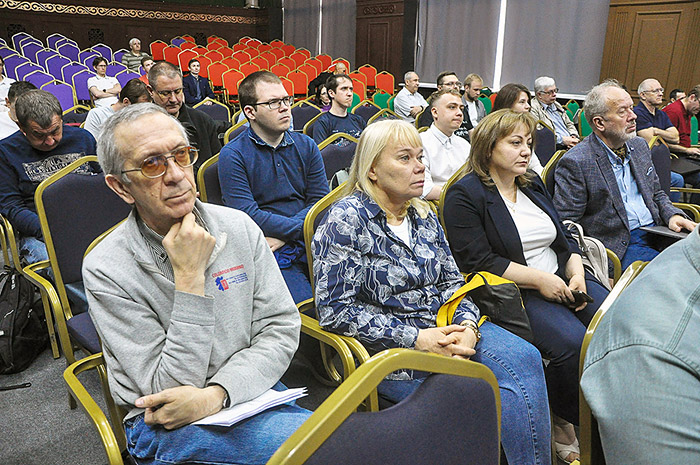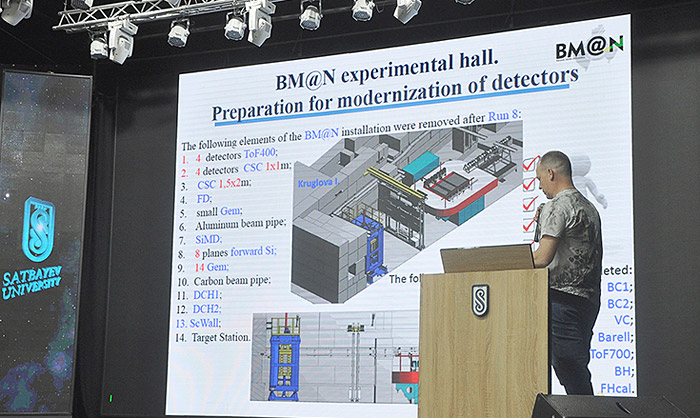
Electronic english version since 2022 |
The newspaper was founded in November 1957
| |
Meridians of cooperation
12th Collaboration Meeting of BM@N Experiment at NICA
starts in Almaty
From 13 to 17 May, Satbayev Kazakh National Research Technical University (Almaty, Kazakhstan) is hosting the 12th Collaboration Meeting of the BM@N (Baryonic Matter at Nuclotron) Experiment at the NICA Accelerator Complex in a hybrid format. The participants are discussing the results of the Collaboration’s research work and further plans for the development of the BM@N Project.
The 12th Collaboration Meeting is devoted to the issues of reconstruction and identification of strange particles and the analysis of the topology of collision events of xenon (Xe) beam nuclei on a caesium iodide (CsI) target obtained during the physics run at the Booster–Nuclotron Complex. In addition, the participants will consider the status of the physical analysis and preparation of publications based on previously recorded data on argon-nuclear interactions. Other topics for discussion include the physics programme and detector configuration for the next run on the BM@N Facility.
Vice-Rector for International Cooperation and Strategic Development of Satbayev University Samgat Yermekbayev opened the meeting. He welcomed the participants and thanked the Joint Institute for organizing the meeting at the University. As Samgat Yermekbayev noted, such events help engage students and young specialists in the global scientific activities.
As part of the plenary session, Collaboration Leader, Head of the VBLHEP JINR Scientific and Experimental Department of Baryonic Matter at Nuclotron Mikhail Kapishin reported on the results and status of the BM@N Project. Currently, 217 representatives from 13 scientific centres of Bulgaria, China, Kazakhstan, Russia, and Uzbekistan are in the collaboration. The results of the physical analysis of argon-nuclear and xenon-nuclear interactions were presented. In addition, Mikhail Kapishin announced plans to improve the facility for future physics runs of the BM@N Experiment.

Deputy Head of the Scientific and Experimental Department of the VBLHEP JINR Multi-Purpose Detector (MPD) Semyon Piyadin spoke about the configuration of the BM@N Facility and the operation of the detectors during the physics run with a beam of xenon nuclei. The design and manufacture of mechanical support structures, based on the changes made during the modernisation of the external tracking system of the BM@N Facility for the next physics run, is completed. The installation of the central tracking system inside the SP-41 Analysing Magnet will begin after the detectors are modernised. As part of preparation for the next run, two large CSC (Cathode Strip Chambers) Detectors and a ScWall (Scintillation Wall) Detector have been installed in the BM@N Experimental Hall, and the aperture of ToF400 (Time-of-Flight) Detectors has been widened.

Deputy Head of the VBLHEP JINR Accelerator Department for Scientific Work Valery Lebedev provided an update on the superconducting accelerators of the NICA Complex, the Booster and the Nuclotron. The report included the results of the fourth commissioning run at NICA and goals of the next stage of work. According to Valery Lebedev, in the near future, due to the modernisation of the collider injection complex, the team plans to adjust the measurement parameters and orbit correction of superconducting accelerators. The acceleration rate of HF systems and the efficiency of beam transmission between the Booster and the Nuclotron are expected to increase. The modernisation of the collider injection complex will increase the beam intensity by about 2 times compared to what was demonstrated during the fourth commissioning run. Due to two ion sources being used (KRION and a laser source), sequential acceleration of heavy and polarised ions for different experiments is planned in future runs. The efficiency of slow beam extraction (from ~30% to ~90%) and the beam transport channel in BM@N will be improved.
During the 12th BM@N Collaboration Meeting, the participants are going to discuss the readiness of BM@N detectors and results of the analysis of the experimental data acquired during the previous runs. In addition, the agenda of the event includes a meeting on software support of the BM@N Experiment. The programme of the meeting features more than 50 presentations on the implementation of the BM@N Project.
On 17 May, the final day of the event, the NICA Days 2024 annual workshop will take place at Satbayev University. Participants will consider the status of the megascience project and the physics programme of experimental facilities of the NICA Accelerator Complex: BM@N, MPD, SPD, and ARIADNA.